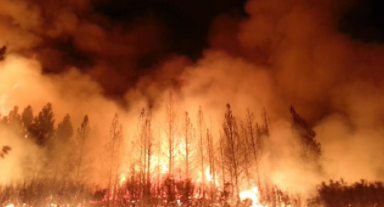History of the California Wildfires

California Rim Fire in 2003.
While the serious extent and impact of California wildfires are commonly known, the recent Thomas Fire, Creek Fire, Rye Fire, Skirball Fire, and Lilac Fire may require an explanation. These fires caused significant damage, with them burning close in time to one another, and the Thomas Fire being one of the largest in history.
The fires are dangerous due to the drying out of vegetation over recent years with the drought. This past year, California received more rain than usual but it only allowed for more vegetation to dry up during the summer. This dry vegetation is easily flammable and can cause the fire to quickly catch and spread. This is coupled with other factors such as strong winds, and mountains difficult to access. The high winds up to 80 mph also cause the fires to spread rapidly, and prevent the fire retardant from being effective. Responders to the fire are noted to have had trouble reaching the problem due the uneven terrain and canyons. The canyons “…act as funnels for the wind, which pushes already heated air upward”, spreading the fires even more (CNN).
The fires in California’s history are said to have been caused by Santa Ana winds, which also aided these multiple fires.The Santa Ana winds blow during the early and late months of the year, carrying warm airs from the desert. According to recent information, the high winds pushing the flames of The Thomas Fire, called for large evacuations, with 981 structures ruined, and burning over 200,000 acres. The Creek Fire damaged 89 buildings and burned over 15,000 acres, being a much smaller fire. The Rye fire covered around 6,000 acres, The Skirball around 400, and the Lila 4,100. For the skirball, there was not a great of significant damage, with a dozen or so buildings being affected and avoiding a museum. On the other hand, the Thomas and Lilac fires burned a significant amount more, both ruining well over a hundred buildings (Business Insider). The flames did cause many to evacuate and major roads to close as a result (TIME).
The Thomas Fire as mentioned was significantly bigger than the other fires, placing at the states largest fire in recorded history. To get an idea of the size, “The Thomas fire has burned an area larger than New York City, Washington D.C. and San Francisco combined”(CNN). A total of 18,000 structures were left threatened by the fire after the first thousand were reached. More than 8,400 firefighters were at work on the fire, and around 110 million dollars spent trying to contain it. The fire unfortunately took the life of one Cory Iverson, a firefighter at work on the flame. Residents of California mention that it seemed as if there were 100 foot flames surrounding them, and were forced to leave with no notice (CNN). The Thomas fire along with the other fires, seemed to have been put to end by the assistance of weather, and efforts made by Cal Fire.









